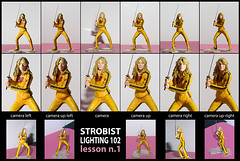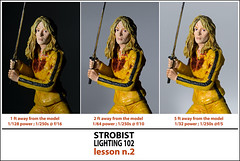 This week we are wrapping up control number one, lighting position. Other than getting the exposure correct, this is the most basic control. But it is also the foundation for just about any light that you will design.
This week we are wrapping up control number one, lighting position. Other than getting the exposure correct, this is the most basic control. But it is also the foundation for just about any light that you will design.  As you spend more time observing and creating various lighting angles, you'll find that this process will begin to get intuitive. You'll know exactly where to put your light(s) based on the look you have preconceived.
As you spend more time observing and creating various lighting angles, you'll find that this process will begin to get intuitive. You'll know exactly where to put your light(s) based on the look you have preconceived. And you'll be able to look at an existing photo and understand where the various light sources are coming from. Even if you can't see them.
 A good understanding of light-to-subject distance as a control will allow you to more effectively light on multiple planes. This will be especially important when you are creating a photo with two or more sources, whether it is multiple strobes or a combination of strobe foreground and ambient background.
A good understanding of light-to-subject distance as a control will allow you to more effectively light on multiple planes. This will be especially important when you are creating a photo with two or more sources, whether it is multiple strobes or a combination of strobe foreground and ambient background.In our next control, apparent light size, we'll learn how the light-to-subject distance will affect not only the quantity but the quality of the light. So being comfy with the distance/intensity thing will make the apparent light size control more intuitive.
As an analogy, being comfy with algebra really helps when you get to calculus. Put differently, if you are not really comfy with algebra, you are a train wreck waiting to happen when you get to calculus.
At Least Remember This
The important takeaways for Control #1:
• The difference between light position and camera position reveal the three-dimensional shape of the subject.
• You can visualize what portion of your subject will be lit by viewing it from the flash's position.
• Lights are extremely powerful when placed close to the subject.
• Lights can illuminate broad subjects more evenly when placed far from the subject, at the expense of power.
• Light-to-subject distance vs. light-to-background distance can be used as a lighting control.
• Varying these ratios can alter a light's useful range. This can be thought of as lighting depth of field.
• This, in turn, can allow a photographer complete control over a background's relative brightness. This is especially important when you are trying to light on two separate planes.
Nice, quiet, easy week. There is no shooting exercise this time. But going forward, your exercise is a continuous one: Try to be more aware of lighting position in your daily life.
Note the way that natural light sculpts the objects around you. Pay special attention to the light that you really like. You'll probably find that it is very different than the light that we tend to create when you get a flash and stick it onto a light stand.
At first, we tend to think of lighting in terms of softened, and placed at a 45-degree angle to the subject. Nice and safe. But a little boring, if you ask me.
Environmentally speaking, I am more likely to react to hard light. Or back light. Or rim light. Or partially obscured light. Or light transmitted through a translucent background. Light that is more unexpected and edgy.
So while the standard, go-to stuff can always be done, I am always looking for an opportunity to create the kind of light that wows me when I see it in real life. And to be honest, it probably makes sense to learn the standard stuff first anyway. It's a good foundation. And depending on what you are shooting, it can really pay the bills.
But do not limit yourself to that. Heck, you're driving, right? Don't always go for the path of least (creative) resistance. Take the curvy, secondary roads. Or go off-road altogether.
This section has been about light quantity and the foundation for light quality. Next week, we'll be hitting apparent light size. And there's a whole lot more going on there than meets the eye.
Controls one and two comprise so many different possibilities that you could spend a career exploring these two alone. (Don't worry, We won't.)
We'll do a couple of exercises on apparent light size and how your subject's tonal range and surface quality affect how it reacts to various size light sources. Then we'll be doing our first full assignments.
_____________________________
Related links:
Exercise 1.1, Lighting | Angle: Lesson | Discussion | Photos
Exercise 1.2, Lighting | Distance: Lesson | Discussion | Photos
NEXT: Lighting 102: Apparent Light Size




0 comments:
Post a Comment